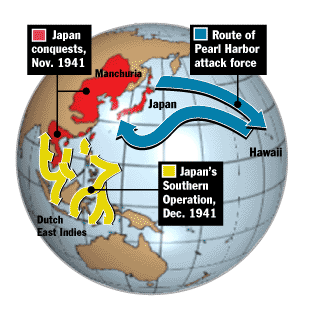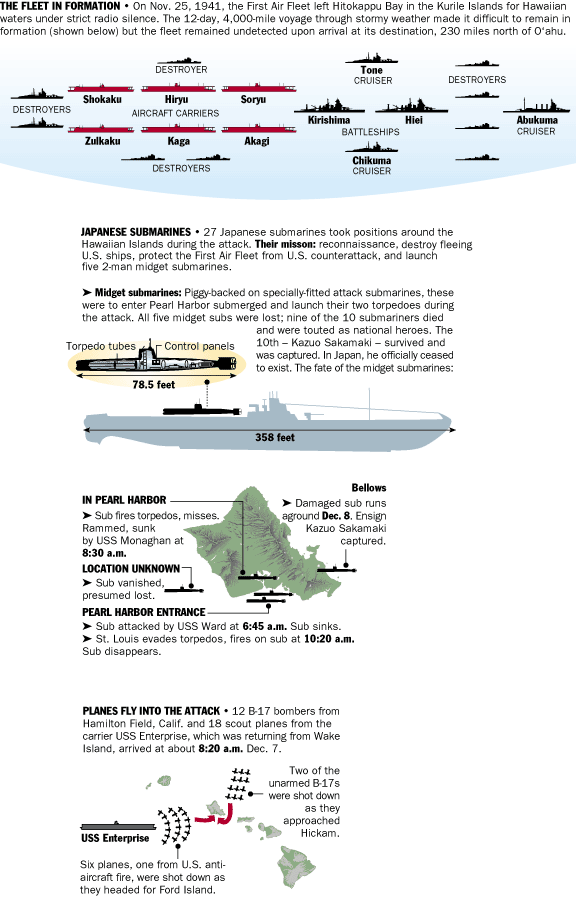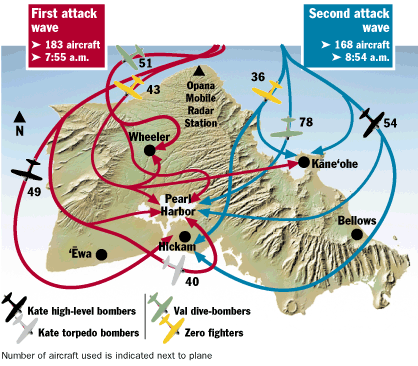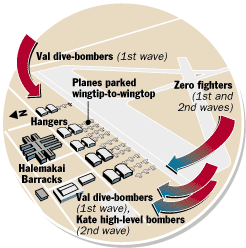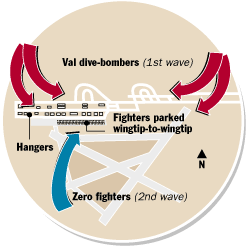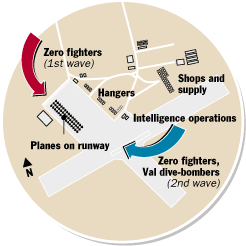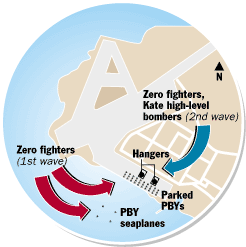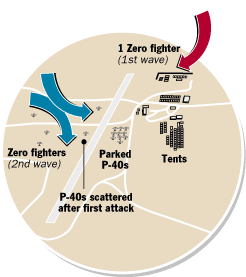 |
 |
|
 |
|
|
Japan builds an empire, then tries to protect it Japan's attack on Pearl Harbor was the first step in the “Southern Operation,” an attempt to invade and conquer resource-rich Southeast Asia. By crippling American naval power in the Pacific, Japan hoped to consolidate and strengthen its hold on its conquests before the United States could rearm.
Prelude to war
Dec. 7, 1941: The Attack and its Aftermath 3:42 a.m. The minesweeper Condor, on patrol near the entrance to Pearl Harbor, spots a submarine periscope 50 yards in the distance. The Condor notifies destroyer USS Ward via blinker-light. 6 a.m. The Japanese attack force, located 230 miles north of O'ahu, turns its carriers into the wind to launch its first wave of planes. Pilots use a Honolulu radio station's music to reconfirm navigation. 200 miles south of O'ahu, the aircraft carrier USS Enterprise launches 18 aircraft to scout ahead and land at Ford Island around 8 a.m. 6:45 a.m. The USS Ward fires on the submarine. The midget sub, struck at the waterline, appears to slow and sink. The Ward then drops depth charges on the craft. At 6:53, two coded messages are sent from the Ward to the 14th Naval Headquarters at Pearl Harbor Naval Station, saying it had "attacked, fired upon, and dropped depth charges upon submarine operating in a defensive sea area." 7:02 a.m. A private at the Army's six-month-old Opana Mobile Radar Station spots a large contact on the radar screen: 50 or more aircraft on a bearing for O'ahu. The private calls the Fort Shafter information center, the hub of the radar network. 7:15 a.m. At Pearl Harbor Naval Station, code clerks decode the destroyer Ward's message about the mystery sub. Adm. Husband E. Kimmel, commander in chief of the Pacific Fleet, decides to "wait for verification" of the report because there had been so many "false reports of submarines" recently. Japanese launch 168 aircraft for second attack wave. 7:20 a.m. Army Lt. Kermit Tyler, who is in training at the radio-network operations center at Fort Shafter gets the Opana radar station report. The lieutenant believes that the radar had picked up a flight of U.S. B-17 Flying Fortress bombers heading from California to Hawai'i. He tells the men: "Don't worry about it." 7:40 a.m. Japanese planes reach O'ahu's North Shore. As they near O'ahu, the attack commander hears a Honolulu weather report: "Clouds mostly over the mountains. Visibility good." 7:49 a.m. Air-attack commander Mitsuo Fuchida, looking down on Pearl Harbor, sees no aircraft carriers, which the Japanese hoped to destroy and thus thwart U.S. retaliation. He orders his telegraph operator to tap out to, to, to: attack. Then other taps: to ra, to ra, to ra: attack, surprise achieved. Though not meant to have a double meaning, to ra is read by some Japanese pilots as tora – tiger. According to a Japanese saying, "A tiger goes out 1,000 ri (2,000 miles) and returns without fail." 7:55 a.m. At the Command Center on Ford Island, Cmdr. Logan C. Ramsey looks out a window and spots a low-flying plane dropping a bomb. Ramsey runs to a radio room and orders the telegraph operators to send out an uncoded message to every ship and base: AIR RAID ON PEARL HARBOR X THIS IS NOT DRILL. The coordinated attack begins as dive-bombers strike the Army Air Forces' Wheeler Field in Central O'ahu and Hickam Field near Ford Island's Battleship Row. Most U.S. planes, parked wingtip-to-wingtip in neat rows to guard against sabotage, are easy targets. 8 a.m. Twelve B-17 Flying Fortresses have been ordered to the Philippines as part of a U.S. plan to bolster the Pacific forces. The first stop is O'ahu. Unaware that Japan is attacking, they prepare to land. Because they are unarmed – to save weight – the B-17s can only dodge Japanese fighters and U.S. antiaircraft gunfire. Most manage to land intact, one of them touching down on a golf course. 8:10 a.m. A 1,760-pound armor-piercing bomb dropped by a high-altitude bomber penetrates the decks of the USS Arizona. The explosion in the forward magazine of the battleship sets off more than a million pounds of gunpowder, and creates a huge fireball. The blast, which sets off shock waves felt throughout the harbor and even by Japanese pilots flying 10,000 feet above, kills 1,177 men aboard. In nine minutes, the Arizona is on the bottom of the harbor and fires aboard it burn for two days. 8:12 a.m. The USS Utah, a former battleship converted into a target ship, capsizes after taking two torpedo hits. Fifty-eight men are lost. 8:17 a.m. Through the flames and smoke, the destroyer USS Helm speeds to the open sea. As the Helm leaves the channel, a lookout spots a Japanese sub snagged on a reef. The Helm "turned hard right toward enemy submarine," shoots – and misses. The two-person sub breaks free and submerges. But it snags again. Trying to escape the foundering sub, one crewman drowns. The next day, the other is washed ashore near Bellows and becomes the United States' first World War II prisoner of war. 8:39 a.m. As the destroyer USS Monaghan tries to get out of the harbor, a nearby U.S. ship signals that it has sighted a submarine. The Monaghan heads for the sub at top speed, hits it with gunfire, then rams it and drops depth charges. The charges are so close that when they explode, the blasts lift the Monaghan out of the water but do not damage her. The sinking midget submarine manages to fire a torpedo. But it does not hit anything. 8:50 a.m. The USS Nevada gets underway and, with anti-aircraft guns blazing, heads for the open sea. Japanese planes of the second wave bomb her, hoping to sink her in the narrow harbor entrance and close off the harbor. Its captain deliberately grounds the ship off Hospital Point to avoid that situation. 8:54 a.m. The second wave of Japanese planes meets heavy antiaircraft fire. Bombers attack the Navy Yard dry docks and hit the battleship USS Pennsylvania. Another bomber hits the destroyers USS Cassin and USS Downes. Onboard ammunition explodes, and the Cassin rolls off its blocks and into the Downes. Bombs hit the light cruiser USS Raleigh. Crewmen jettison gear to prevent capsizing. 9:30 a.m. A bomb blows off the bow of the destroyer USS Shaw, creating a massive explosion that cuts the ship in two; pieces of the ship rain down half a mile away. 10 a.m. The second wave of Japanese fighters heads back to the carriers. Of the 29 Japanese planes lost, anti-aircraft guns probably shot down 15. Exuberant Japanese pilots urge a third strike on Pearl Harbor, particularly gasoline tanks which supply fuel to ships and planes. Aftermath Japanese commanders, saying the attack has been successful, rule out a third strike. One reason is a possible retaliation by U.S. aircraft carriers that were not in the harbor. By 1 p.m., the strike force is on its way home.
|
|||||||||||||||||||||||||||||||||||||||||||||||||||||||||||||||||||||||||||||||||||||||||||||||||||||||||||||||||||||||||||||||||||||||||||||||||||||||||||||||||||||||||||||||||||||||
Main | Photo Gallery | Multimedia | Resources | Daily Stories
© COPYRIGHT 2001 The Honolulu Advertiser, a division of Gannett Co. Inc.
Use of this site indicates your agreement to the Terms of Service (updated 08/02/01)
